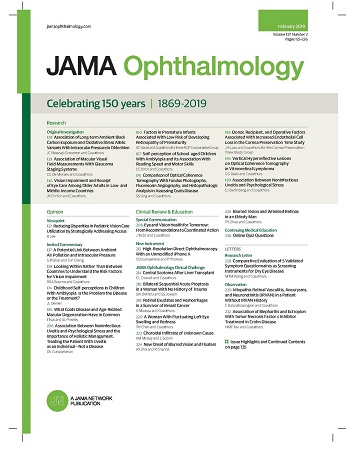Short-Term Ocular Biometric Changes as Predictors of Long-Term Angle Closure Progression
IF 7.8
1区 医学
Q1 OPHTHALMOLOGY
引用次数: 0
Abstract
ImportanceBaseline ocular biometrics of the anterior segment forecast progression from primary angle closure suspect (PACS) to primary angle closure (PAC). As ocular biometrics change with aging, it is also important to understand the progression risk associated with these longitudinal anatomical changes.ObjectiveTo assess 18-month ocular biometric changes as risk factors for progression from PACS to PAC between 36 and 72 months.Design, Setting, and ParticipantsThis retrospective cohort study analyzed data from the prospective Zhongshan Angle Closure Prevention (ZAP) Trial, which was a randomized clinical trial conducted from September 2008 to November 2018. Participants were aged 50 to 70 years and had bilateral PACS, defined as inability to visualize pigmented trabecular meshwork in 2 or more quadrants on gonioscopy. Participants were evaluated at baseline, at 2 weeks, and at 6, 18, 36, 54, and 72 months for progression to PAC, defined as development of intraocular pressure greater than 24 mm Hg, peripheral anterior synechiae, or acute angle closure. Untreated eyes without progression at or before 18 months were eligible. Cox regression models assessed risk factors for progression. Data were analyzed from November 2023 to June 2024.Main Outcome and MeasureProgression from PACS to PAC between 36 and 72 months.ResultsA total of 785 untreated eyes (759 without progression, 26 with progression) of 785 participants were analyzed (mean [SD] age, 58.7 [5.0] years; 651 females [82.9%], 134 males [17.1%]). In univariable Cox models, baseline trabecular-iris space area at 500 μm (TISA500) and 18-month change in lens vault (ΔLV) and TISA at 750 μm (ΔTISA750) were associated with progression. In age-adjusted multivariable Cox models, baseline TISA500 (hazard ratio [HR], 1.28 per −0.01 mm短期眼生物特征变化作为长期闭角进展的预测因子
重要意义前段基线眼生物特征预测从原发性闭角可疑(PACS)到原发性闭角(PAC)的进展。由于眼部生物特征随着年龄的增长而变化,了解与这些纵向解剖变化相关的进展风险也很重要。目的评估18个月时眼部生物特征变化作为36 - 72个月间PACS发展为PAC的危险因素。设计、环境和参与者本回顾性队列研究分析了2008年9月至2018年11月进行的前瞻性中山角闭合预防(ZAP)试验的随机临床试验数据。参与者年龄在50到70岁之间,患有双侧PACS,定义为无法在两个或更多象限上看到色素小梁网。在基线、2周、6、18、36、54和72个月时评估参与者进展为PAC的情况,PAC的定义为眼压大于24 mm Hg、周围前粘连或急性闭角。未治疗的眼睛在18个月或之前没有进展。Cox回归模型评估进展的危险因素。数据分析时间为2023年11月至2024年6月。主要结局和测量方法从PACS进展到PAC的时间为36 - 72个月。结果785名受试者共785只眼(759只眼无进展,26只眼有进展)接受治疗(平均[SD]年龄58.7[5.0]岁;女性651人(82.9%),男性134人(17.1%))。在单变量Cox模型中,基线500 μm的小梁-虹膜间隙面积(TISA500)、18个月的晶状体穹窿变化(ΔLV)和750 μm的TISA (ΔTISA750)与进展相关。在年龄调整的多变量Cox模型中,基线TISA500(风险比[HR], 1.28 /−0.01 mm2;95% ci, 1.09-1.50;P = 0.006)和ΔLV (HR, 1.22 / 0.1 mm;95% ci, 1.07-1.41;P = 0.008)(一致性指数,0.73)或基线TISA500 (HR, 1.31 / - 0.01 mm2;95% ci, 1.11-1.54;P = 0.003)和ΔTISA750 (HR, 1.06 / - 0.01 mm2;95% ci, 1.02-1.10;P = 0.009)(一致性指数,0.73)比单独基线TISA500更具预测性(HR, 1.27 / - 0.01 mm2;95% ci, 1.09-1.49;P = .007)(一致性指数为0.69)。分类TISA500在最低四分位数(<0.031 mm2;人力资源,2.65;95% ci, 1.20-5.86;P = .03)和ΔLV在最高四分位数(>0.663 mm;Hr, 2.70, 95% ci, 1.23-5.93;P = .02)独立赋予更大的进展风险(一致性指数,0.69)。短期(18个月)LV和TISA750的变化与未经治疗的PACS眼的长期(36-72个月)闭角进展相关,这表明监测晶状体尺寸或位置和角度宽度的变化可以增强基线眼生物识别技术对长期闭角进展的预测性能。
本文章由计算机程序翻译,如有差异,请以英文原文为准。
求助全文
约1分钟内获得全文
求助全文
来源期刊

JAMA ophthalmology
OPHTHALMOLOGY-
CiteScore
13.20
自引率
3.70%
发文量
340
期刊介绍:
JAMA Ophthalmology, with a rich history of continuous publication since 1869, stands as a distinguished international, peer-reviewed journal dedicated to ophthalmology and visual science. In 2019, the journal proudly commemorated 150 years of uninterrupted service to the field. As a member of the esteemed JAMA Network, a consortium renowned for its peer-reviewed general medical and specialty publications, JAMA Ophthalmology upholds the highest standards of excellence in disseminating cutting-edge research and insights. Join us in celebrating our legacy and advancing the frontiers of ophthalmology and visual science.
 求助内容:
求助内容: 应助结果提醒方式:
应助结果提醒方式:


